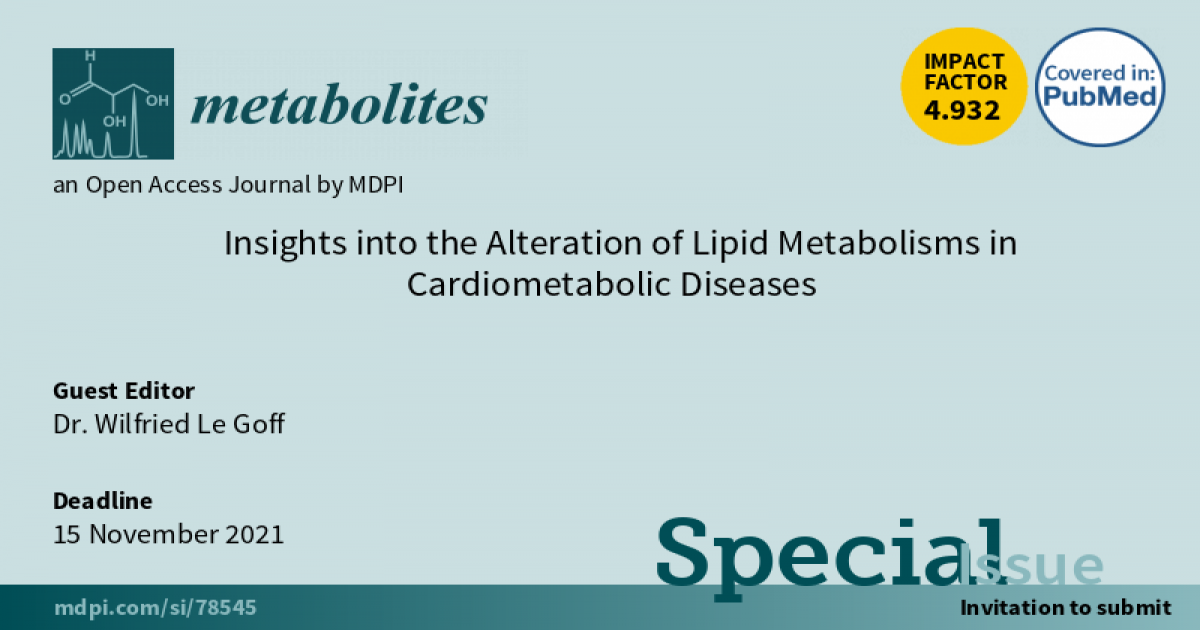Insights into the Alteration of Lipid Metabolisms in Cardiometabolic Diseases
A special issue of Metabolites (ISSN 2218-1989). This special issue belongs to the section "Lipid Metabolism".
Deadline for manuscript submissions: closed (15 November 2021) | Viewed by 106784

Special Issue Editor
Interests: lipids; lipidomic; lipoproteins; macrophages; cardiometabolic diseases
Special Issues, Collections and Topics in MDPI journals
Special Issue Information
Dear Colleagues,
Cardiometabolic diseases are characterized by major alterations in lipid metabolism affecting both systemic and cellular compartments. Consumption of lipid-enriched diets induces major modifications in concentration and composition of circulating lipoproteins causing dyslipidemia. Importantly, dietary lipids profoundly impact the synthesis of lipoproteins in specialized tissues as well as the complex lipid composition of lipoproteins with consequences on their biological activities. At the cellular level, dietary lipids together with the disturbed lipoprotein phenotype induce a profound change of lipid metabolism in major tissues including but not limited to liver, adipose tissue, intestine, pancreas, muscle and heart participating to their remodeling and in some cases to their metabolic activation as observed in macrophages. Such a remodeling may occur through alterations in membrane lipid structure, signaling pathways, generation of bioactive or cytotoxic lipids as well as in the capacity to handle this excess of lipids (storage vs catabolism vs recycling). All these modifications participate to the development of the spectrum of metabolic disorders including obesity, insulin resistance, diabetes, non-alcoholic fatty liver diseases and atherosclerosis contributing to cardiovascular diseases.
This special issue of Metabolites will be dedicated for publishing current advances on mechanisms underlying these alterations of the systemic and cellular lipid metabolism as well as their biological consequences in the context of cardiometabolic diseases. All the fields related to the study of lipids involving genetic/epigenetic, biochemical, molecular, cellular and omics approaches will be covered in this issue.
Dr. Wilfried Le Goff
Guest Editor
Manuscript Submission Information
Manuscripts should be submitted online at www.mdpi.com by registering and logging in to this website. Once you are registered, click here to go to the submission form. Manuscripts can be submitted until the deadline. All submissions that pass pre-check are peer-reviewed. Accepted papers will be published continuously in the journal (as soon as accepted) and will be listed together on the special issue website. Research articles, review articles as well as short communications are invited. For planned papers, a title and short abstract (about 100 words) can be sent to the Editorial Office for announcement on this website.
Submitted manuscripts should not have been published previously, nor be under consideration for publication elsewhere (except conference proceedings papers). All manuscripts are thoroughly refereed through a single-blind peer-review process. A guide for authors and other relevant information for submission of manuscripts is available on the Instructions for Authors page. Metabolites is an international peer-reviewed open access monthly journal published by MDPI.
Please visit the Instructions for Authors page before submitting a manuscript. The Article Processing Charge (APC) for publication in this open access journal is 2700 CHF (Swiss Francs). Submitted papers should be well formatted and use good English. Authors may use MDPI's English editing service prior to publication or during author revisions.
Keywords
- Lipid
- lipidomic
- lipoprotein
- membrane
- obesity
- diabetes
- insulin resistance
- NAFLD
- atherosclerosis
Benefits of Publishing in a Special Issue
- Ease of navigation: Grouping papers by topic helps scholars navigate broad scope journals more efficiently.
- Greater discoverability: Special Issues support the reach and impact of scientific research. Articles in Special Issues are more discoverable and cited more frequently.
- Expansion of research network: Special Issues facilitate connections among authors, fostering scientific collaborations.
- External promotion: Articles in Special Issues are often promoted through the journal's social media, increasing their visibility.
- e-Book format: Special Issues with more than 10 articles can be published as dedicated e-books, ensuring wide and rapid dissemination.
Further information on MDPI's Special Issue policies can be found here.






